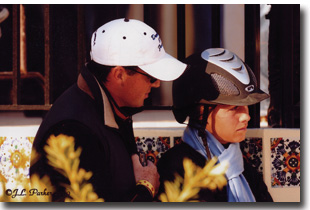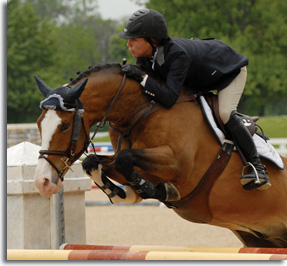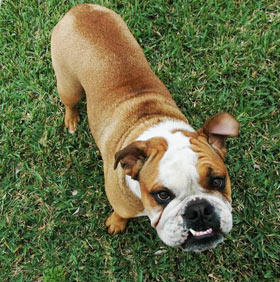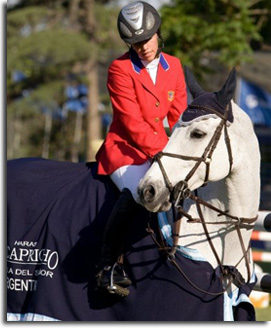By Jackie McFarland
Rebecca Johanson Hofmann of Blue Hill Farm
Young and settled. That defines the up and coming equestrian who has not only established her home and business in Wellington but will soon tie the knot. Becky Hofmann  set her sights on this life long ago and now she is living it. Always looking to be at the top of her game, she develops her own horses. With partner and soon to be husband Conan Conway, she seeks and finds quality horses, keeping a select group for sale on her farm. Located in the equestrian neighborhoods that are literally a ride away from the Palm Beach International Equestrian Center, Blue Hill Farm is not only a great little facility, it isthe place where everyone goes to test their poker skills on Monday nights during the season. The evening’s winner could walk away with a nice sum of money, and everyone has a great time.
set her sights on this life long ago and now she is living it. Always looking to be at the top of her game, she develops her own horses. With partner and soon to be husband Conan Conway, she seeks and finds quality horses, keeping a select group for sale on her farm. Located in the equestrian neighborhoods that are literally a ride away from the Palm Beach International Equestrian Center, Blue Hill Farm is not only a great little facility, it isthe place where everyone goes to test their poker skills on Monday nights during the season. The evening’s winner could walk away with a nice sum of money, and everyone has a great time.
After we toured the barn, Chloe had a chance to sit bareback on Corona, Becky’s great gray Grand Prix mare. We played in the grass with the barn mascot Uma, an irresistible English Bulldog, and then interviewed Becky.
EqSol: From what age did you know that this was your thing?
BH: I always knew I wanted to ride, but by age 12 I knew that I wanted horses to be my career. Growing up in Salt Lake City, Utah I didn’t have a lot of riding options. So at 15 I spent the summer riding with Betty Beran in Scottsdale, AZ. I wanted more. I convinced my mom to let me move to Scottsdale when I was 16. From that point my education was planned around riding – I graduated early both from high school and from college. I decided to go to Arizona State University so I could keep riding with Betty.
I rode with Betty and Renee Wasnik for from age 15-20. They definitely made a solid influence on my riding. I had a lot of opportunities to watch and catch ride. Betty and Renee introduced me to a lot of other professionals including Hap Hansen and Barney & McLain Ward.
EqSol: So you turned 20 and you had graduated from college. What next?
BH: During my last semester of college I was trying to qualify for the World Cup Finals with Corona. It was never really in the cards, but when I found myself in the top three qualifiers midway through the qualifying season, I thought why not give it a whirl? In the end I was named the alternate and stayed home. At the time I was disappointed, but now I know that I was a long way from being ready for that kind of competition. Everything happens for a reason. After graduation I moved to southern California for a short time to finish that season. Then I headed east.
I only planned to come out for The National Horse Show, which was in Wellington in December that year. It ended up being a huge transition in my life – riding was always a priority, but school had kept me so busy, with graduating early and riding too, that I hadn’t stepped back and made any decisions about what I was doing next. After watching top riders and seeing the tremendous opportunity to learn here in Wellington I decided to stay.
I had graduated from school and it was time for me to get an education in the world where I yearned to have more success. I had a lot to learn about the business and about riding. Spending time out here I was able to soak it all up – from all the perspectives – riding, managing horses – how the best do every step. My eyes were wide open and I realized all I didn’t know and was ready to focus on becoming a better horseman all the way around.
That was four years ago – 2007 – this is my fifth circuit here. A lot has changed.
EqSol: And now you are halfway through your twenties and you have an established business. What is the focus?
BH: I am a rider – I have big goals, dreams and aspirations as a rider. I’m not scared of hard work but I will have to work to get there. Conan and I find, buy, train and sell horses while always looking for those top young ones.
I’m paving the path, taking the steps – it’s a long road to the top. The means to the end goal is buying and selling. It is the best way to produce an income as well as develop myself as a rider.

Now with a few years under our belt, we are getting our plan under way. Every year Conan and I set a reasonable goal so sell “x” amount of horses, so far we have been really lucky and have been able to meet our goals each year. And of course the number grows as our business grows. Most of the horses we buy are to resell, but I always have my eye out for a special one for myself.
The focus is also to continue to challenge myself and improve my riding. Three years ago, after the Nations Cup in Buenos Aires and with the help of George Morris, I chose Jeffrey Welles as my mentor.
Jeffrey is a real horseman, and a great person. I try to watch him on all of his horses, from the young ones to the seasoned ones. He has an amazing feel for producing young horses. If I can absorb a small fraction of what he has to offer, I will be doing very well.
EqSol: Where do you find your ‘stock’?
BH: Our contacts are in France, Belgium and Holland. Those types of horses suit the way I ride. The horses that go similarly to my methods are easier for me to bring along and also sell. There is no point for me to buy something that doesn’t suit my way of riding.
Each horse has to vet well, be attractive and nice to ride, we don’t care which arena it will go in. They can suit any ring with those attributes. We keep a select group of these types. They are all nice horses.
EqSol: Tell us more about the ‘we’ part of you.
BH: Conan is my business partner and my fiancée – he is what Blue Hill Farm has been missing. He fills in all the gaps and is strong where I’m weak. He works with clients, is great with horses on the flat and works with me on the ground. It’s a whole different ball game for me now when getting ready for a big class – now I can just show up and think about the horse, my ride – I’m not handling every detail because Conan does it. This is the first time I feel like I have the right team – where everything falls into place. A match made in heaven.

We met for the first time at Spruce Meadows in 2007. We started dating later that year. We had a similar schedule – six months in the northeast, six months in Florida. We got engaged on Conan’s birthday just over two years ago and also decided to merge our businesses. We decided to establish our business before we planned the wedding. The operation is small enough that we both need to focus on it full time. Now the wedding is coming up – time flies!
EqSol: The Blue Hill Farm mascots?
BH: Biggz is an eight year old mini-pin. He’s a one-person kind of guy, so he tolerates Conan. Uma is our bulldog, just coming two years old. She’s our ‘baby’. Biggz could live without us, he is a very unique kind of dog. Uma is a lover and couldn’t survive without us. We love them both of course.
EqSol: The Blue Hill Farm horses…
BH: Corona – my great gray mare recently retired and is hopefully heading into motherhood. I’ve had her for close to eight years. She was my first grand prix horse – my entree into all the big classes. I rode her in my first NAJYRC, had my first grand prix win on her and rode her in my first Nations Cup. She’s the foundation. I have her to thank for everything.

I found her when I went to Barney’s to ride and try horses for a week. When I saw her there and tried her, she wasn’t the right horse at the time but I just had the feeling that she was the horse for me. I probably needed more of a ‘slave’ at that time, which she wasn’t. It took me a long time to get it together with her. But in the end we formed a great team. She taught me so much, and gave me a small taste of what I am setting my life up to work towards.
Corona is now living at my vet’s farm in Lexington, Kentucky getting ready to be put into foal to Chacco-Blue. And I can’t wait!
Twister – I was able to purchase Twister about a year ago. I had my eyes on him for a couple of years showing in the amateur jumpers with another rider. I just knew that he would suit my riding. When the opportunity came along to buy, I jumped at it. He is new to the Grand Prix Level. I had some very nice results with him last spring and summer. We are starting to gear him up for this season. I think he is a top 1.50 meter horse, a great mount for the spring and summer Grand Prix classes.
Zenith B – Blue Hill’s newest horse, he was purchased at the end of 2010. I have a very good feeling about this horse. He is coming seven this year, and still very green, but I believe he has all of the attributes to become a top horse. Now it is up to me not to mess with his natural instincts and abilities. I am learning to take it slow with him and keep the big picture in mind as he develops.
EqSol: So what does the future hold for Mrs. Conway?
BH: I love riding. I love being in the ring. It’s really hard to be at the top, but I’m going for it, one step at a time. I’m working on building a reputable business while I continue to work on developing competitive horses. I’m involved in every aspect. From a bug bite to a hot leg, there’s not one thing that goes on with my horses that I don’t know about it. I’ve learned so much about the business and even though I wish I could speed up the process, I would be skipping out on a lot of the education. Sure I want to be a contender and be recognized and have horses to compete on at the team level. I keep telling myself if I work hard, and keep learning, I’ll get there.
The goal is that when we are big enough I’ll have a string of four or five horses and Conan will handle the sales horses, we’ll always have a string of those too. That will come in time. Sometimes it is hard to be patient but I’m enjoying the journey.
Thank you Becky. We admire your commitment and it seems the path of passion, perseverance and patience you are paving is a road to success!